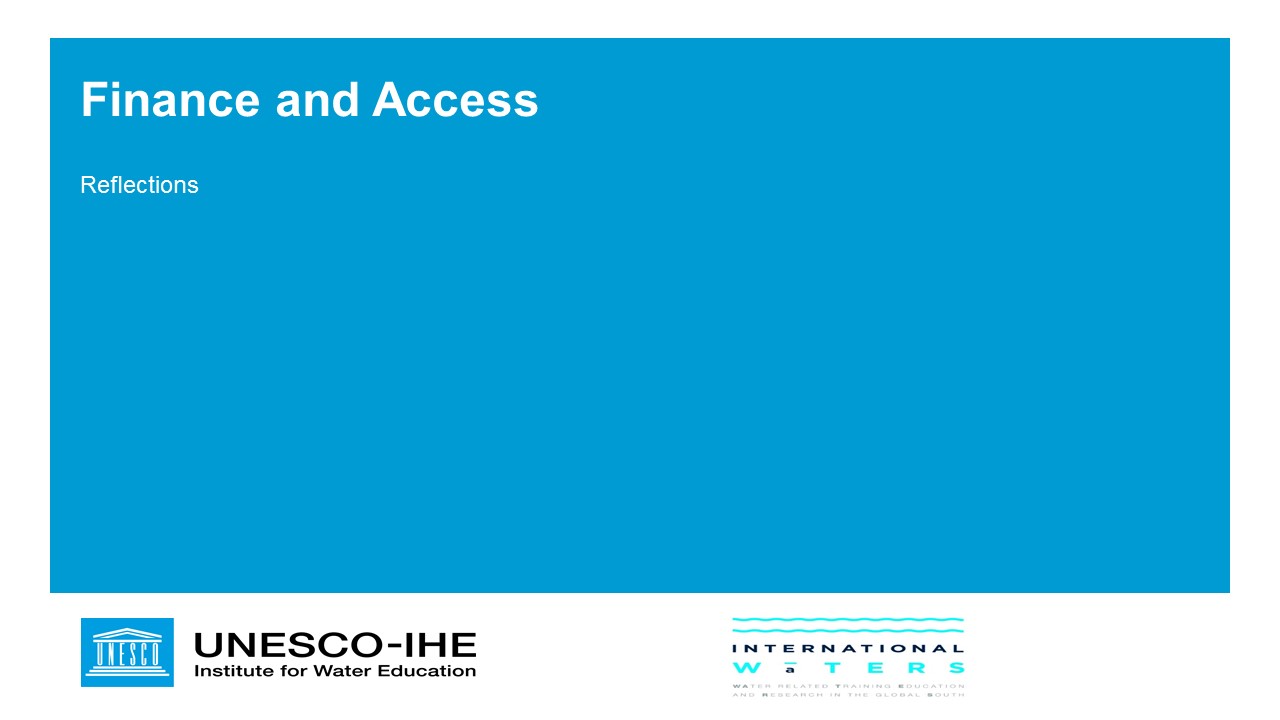This submodule highlights the relationship between financing and access to water. In exploring that relationship the session covers the trends of financial mechanisms in the water sector (public and private funds) and how these strategies impact equitable access to water for all.
In this, more or less, one-hour submodule we have put together several material around widely spoken topics such as Finance and Finance for increased Access to (water and sanitation) Services. We briefly introduce the logic of talking about Finance when discussing increased access, and review a few of the latest trends in the sector. Our aim for this submodule is to bring together several discussion points under this topic and raise questions related to the last trends in the sector that we believe remain relevant in increasing access to services, but to make sure that that access is provided in an equitable manner, in view of the implementation of the SDGs (SDG6: ensure access to water and sanitation for all in an equitable manner). This is just an appetizer, there is a lot of material available online, we hope these thoughts trigger your search for more sources to enhance the discussion!
This submodule has been put together by Mireia Tutusaus Luque. Mireia is a Lecturer in Water Services Management in the Department of Integrated Water Systems and Governance at the UNESCO-IHE Institute for Water Education. She has experience in the private sector, in retail banking and the chemical industry before she started a career in education and training in the field of Water Services and Management. Her main area of expertise is the development and analysis of business and governance models of the provision of drinking water services in urban areas, with a specific interest on financial sustainability and financial implications of infrastructural development. She has supported and coordinated the development of training programs as part of the educational activities at the Institute, as well as external projects in the field of Water Services in various countries in Asia and Africa.
Learning Objectives
- Reflect on the role that finance plays in achieving access.
- Recognize the trends in finance in the water sector.
- Identify different financing approaches in the water sector and their potentials and limitations.
- Reflect on the roles of public and private actors in financing access.
Key Concepts
Financing approaches, public and private finance, traditional and alternative mechanisms
1. Financing Access: Why is it important?
The following presentation* discusses the importance of financing in relation to water access. Write down the key points mentioned in the video.
To complement the information provided in the presentation you can read the pages 5-12 of the following report produced by the World Water Council. It briefly presents the the current (2015) global situation in terms of water infrastructure and financing (see references below).
2. Practical case
Now have a look at the following clip “Action for Access: Public-Private Finance in Water and Sanitation” produced by World Bank Water (2010). The video discusses real cases of public-private financing in the water sector.
3. From traditional sources to new ‘actors’
In the previous section we have been introduced to the needs for water financing. In this section we will discuss different sources of finance that have and are used in the sector.
To start have a look at this presentation*:
The three main ideas discussed in the presentation are:
- Traditional mechanisms of financing the water sector were based on the so called 3Ts.
- However they are not enough to cover all investment needed.
- Alternative financing strategies are being developed
The following blog post written by Catarina Fonseca- Head International and Innovation Programme of IRC- WASH develops more in depth some of these ideas. Financing universal access: the role of Water Financing Facilities.
Practical assignment
In the following two clips you can watch examples of traditional and innovative ideas for financing the water sector. While watching the videos pay attention to the following questions:
- Who are the actors involved in financing in each of the clips?
- What are the positive and negative sides in each of the cases?
The first clip was produced by World Bank Water (2012) and showcases the innovative Maji Ni Maisha (“Water is Life”) project. The second clip was filmed at the IRC WASH Event: public finance for reaching scale and sustainable water and sanitation services in 2014 and discusses the role of public finance for reaching scale and sustainable water and sanitation.
Concluding reflections
As a closure to the submodule, the following clip gives you a glimpse on how the future of financing in the water sector will look like:
“The World Bank Group brought together development organizations, governments, the private sector and civil society to discuss what it will take to finance development in a post-2015 world. The discussion showcased the latest thinking on domestic resource mobilization, private sector leverage, and development financing mechanisms, solutions and initiatives that go beyond filling financing gaps.”
This PowerPoint presentation* summarizes and reflects on the main ideas discussed in this submdoule:
* All presentations in this submodule have been created by Mireia Tutusaus-Luque (Lecturer/Researcher in Water Services Management at IHE Delft) in 2015 for the The International WaTERS online modules.
Key Readings
Key Readings
- World Bank Group (2015) A water-secure world for all.
- Winpenny, James (2003) Financing Water For All. Report of the World Panel on Financing Water Infrastructure. World Water Council.
- OECD (2010) Innovative Financing Mechanisms for the Water Sector. - Executive summary
- Fonseca, Catarina (2015) Financing universal access: the role of Water Financing Facilities
Discussion Questions
Discussion Questions
- What is that needs to be financed in the water and sanitation sector? why? who is financing it?
- What are the different financing approaches discussed in the submodule? what are the positive and negative sides in each of the cases? what are the roles of public and private actors?
Further Readings
Further Readings
- Marson, M. and Savin, I. (2015). Ensuring Sustainable Access to Drinking Water in Sub Saharan Africa: Conflict Between Financial and Social Objectives. World Development 76 (p. 26-39
Other related International Waters Lessons and Submodules
Next submodule: Equity and participation on water access


